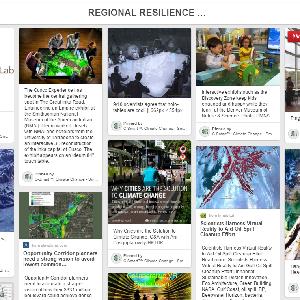
Visualizing Climate Change With Virtual Reality at Climate Resilience Centers. by Team Climate-Smart
 Michael Schnatzmeyer Jun 15, 2016 04:34 | Proposal contributor Judges' Comments & Response. Thank you for the excellent Judges’ Comments (JC)! We will seek to address them in the proposal as well as directly here Response: Thank you! - while Virtual Reality will be key, it is but one of many emerging visualization tools and technologies utilized in the Center. At the forefront is the idea of “Resilience Centers” that can be scaled and replicated around the world. Technologies constantly change. The specific uses of VR will be embedded in the ARC facility program and design and will emerge out of the design competition itself. It likely be used differently at different locations over time. (i.e. to dive the Great Barrier Reef in Australia, perhaps visit declining snowfalls at ski resorts in Austria). Reply: Yes, buildings do take time and also great expense to develop. At this point, we are seeking to only create the “Vision” for such ARC facilities in order to seed the conversation and discourse about their physical creation and roll-out across the US. That would include involving other disciplines such as Real Estate and Business Schools for economic viability, Communications and Behavior Schools for understanding public interaction and communication, etc. Yes we have a long and established history with CU and envision beginning with them and Climate Research Labs locally, and expanding nationally as we work out the program materials and process of the larger “design competition” itself, concurrently with building sponsorship and stakeholder alliances. Reply: Boulder is considered a global epicenter of tech talent and resources, and with the new Google Campus underway, this will only accelerate. It is also the home of more Federal Climate Research Labs than anywhere on earth. We have initiated associations with a number of entities and individuals in regards to VR and digital technologies, but out of respect of the strategic business plans, “brands”, and PR campaigns of those entities, are not able to be more specific at this time. Suffice it to say that there is no shortage of interest in participation in this emerging trillion-dollar market opportunity, but that details of roles, responsibilities and relationships will take time to delineate and make public. Reply: Yes, we have already worked with CU and other institutions for several years prior to the 2013 Colorado flood event, on a comparable planning project to raise awareness about mitigating flood impacts due to climate change and a 100-year flood. Links to student work is noted in the References section. Our roll-out to larger audiences will be through marketing the contest itself, and ultimately construction of the first ARC Centers in Colorado and other locations. ARC Centers are intended to overlap with Tourism promotion to attract the general public (with the attraction of VR technology, etc.) to visit. (See comments below and References section for Institutional relationships) Reply: Thanks, yes it’s a bit buried, and also one of our favorite lines. We’ll try to make it more prominent in the proposal. There much to be said, and it’s hard to get it all to rise to the top. Reply: We have already initiated such discussions and had a great outpouring of support. The concept was embraced by the Governor’s Office and State of Colorado as a component in their application to the $1Billlion HUD/NDRC competition. While it was unfortunately not funded by HUD at this time, this prior work has fostered relationships and networks that can be built on herein. We will continue to expand and evolve these relationships over time. Reply: We will utilize many social channels. Pinterest has been found simply to be a great visually-oriented “bookmarking” site for reference materials that team members can share and build upon. We will build a website to “house” the project, and certainly Facebook, Twitter, et.al. will become key channels for communications and marketing as well. Reply: Yes, the proposal has evolved from literally years of different discussion frameworks, resulting has many facets and components that make it challenging to fully communicate within this limited framework. The key point of utilizing the Student Competition context is to create a more compelling Vision for the ARC centers, including physical designs, and program materials, and a more comprehensive discussion of all of its facets and benefits. We strongly believe that Resilience Centers will become a “defacto” part of society, necessary to address climate change. We expect to quantify the roll-out and construction of facilities and number of visitors, meetings held, funds raised, initiatives and ventures started at facilities, etc.. We will also be able to quantity the scope of program materials, resources, and entities involved and showcased. The larger impact of changing public perceptions may be more difficult to quantify but are expected to be significant to society. (Note Our efforts of utilizing the Beta version of the Impacts Tab and connecting with support staff was a bit frustrated by working within the limited time frame of the contest. The tool and assistance process I’m sure will evolve to be of more benefit to future competitions over time). Thank You, - Team Climate Smart |